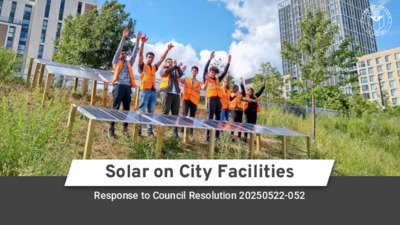2. Staff Briefing on Solar on City Facilities — original pdf
Backup

Solar on City Facilities Response to Council Resolution 20250522-052 Resolution 20250522-052 • Conduct an analysis of City property and make recommendations for the areas that would maximize the installation of solar generation, prioritizing general fund properties. • Annually calculate any energy cost savings or revenue generated and utilize an equivalent amount of funding for projects that have a beneficial environmental impact. • Evaluate opportunities for the installation of solar capacity on properties owned or operated by other local governmental entities within the Austin Energy load zone. • Analyze and make recommendations for requiring solar contractors who install City-owned solar installations to comply with the highest level of worker protections, wage rates, benefits and utilization of Department of Labor registered apprenticeship programs and/or graduates from the Austin Infrastructure Academy. 2 A Changing Federal Solar Landscape Inflation Reduction Act (2021) • • Elective pay allows cities to benefit 30% tax credit available One Big Beautiful Bill Act (2025) • Phases out tax credits for clean energy (including solar). • Projects must “commence construction” by July 4, 2026 to get 100% of the federal tax credits. OR • Projects must be placed into service before the end of 2027 to get 100% of the federal tax credits. • New restrictive Foreign Entity of Concern (FEOC) rules (details TBD) starting next year. Case Study: San Antonio ● Planned 13.1 MW of solar on 42 facilities and parking lots with $30 million investment, $$7- 11 million net savings over 25 years ● Leveraged 30% elective pay tax credits + $2.5 ● Sites identified and narrowed based on technical feasibility, system size estimated ● Flexible RFP offered with 80 sites ● Big Sun Solar Selected as master million low-interest SECO loan developer, separate O&M contract signed Lessons Learned: San Antonio • Do upfront analysis to de-risk RFP and increase competitive responses. • • Engage with departments and building managers early in the process. Streamline internal procurement processes to speed timelines. • Use a multi-site approach and bulk purchasing for economies of scale. • Consider long-term operations and maintenance. Assess Inventory and assess current city facilities for solar potential Prioritize sites that maximize benefits Engage with building owning departments upfront to build support Engage with procurement and finance Procure Issue RFP for multiple sites to achieve economies of scale Evaluate proposals and ownership models: 1. City Owned 2. Power Purchase Agreement 3. Solar Standard Offer Decide and Build Select winning proposals and identify funding (if applicable) Build Solar ASAP to leverage tax credits Build O&M into the contract for long-term performance Approach 6 Collaboration with RMI (Rocky Mountain Institute) • Independent, nonpartisan, nonprofit that transforms global energy systems through market-driven solutions to secure a clean, prosperous, zero-carbon future for all. • Collaborated with San Antonio on their solar procurement. • Hired by OCAR with a Professional Services Exemption to: • Assess CoA facilities and properties for solar viability. • Conduct portfolio-level financial modeling. • Develop procurement strategy and procurement documents for future multi-site solar development RFP. 7 Collaborative Team Effort Office of Climate Action and Resilience Project management and coordination. Building Services Department Site screening and analysis, outreach to building managing departments, outreach to operations staff. Austin Energy Subject matter expertise, electric service analysis, support for RFP development and evaluation. Finance and Procurement Guidance on timelines and requirements, early engagement to expedite processes. Rocky Mountain Institute Detailed site analysis, financial modeling, procurement strategy design. 8 Next Steps 1 Memo to Council due September 2 2 3 4 Weekly team meeting with core departments and RMI + engage broader set of stakeholders Further site screening and analysis, prioritization of sites and portfolio-level analysis Present to Climate, Water, Environment, Parks Council Committee 5 RFP development and release 9 Thank you!